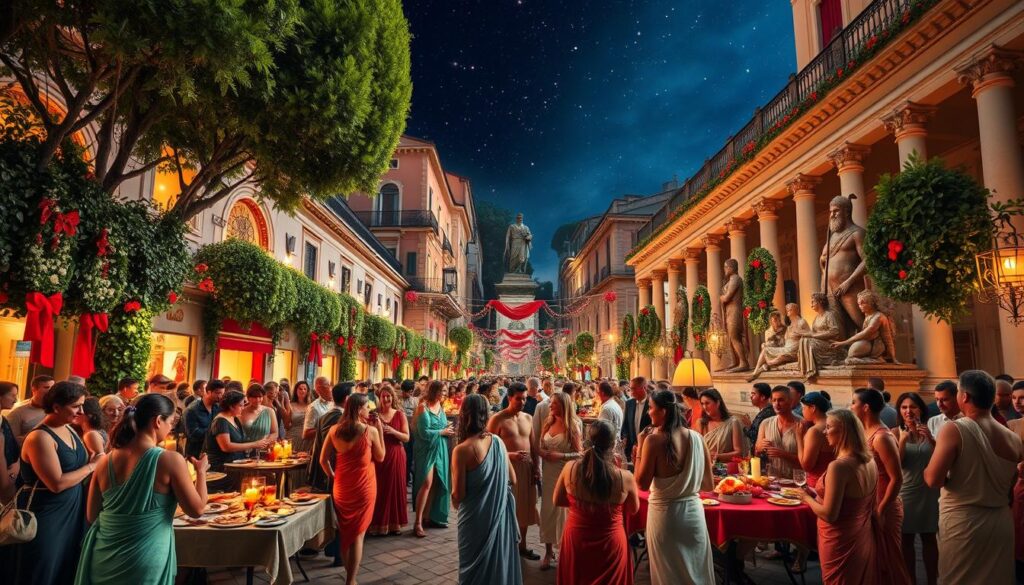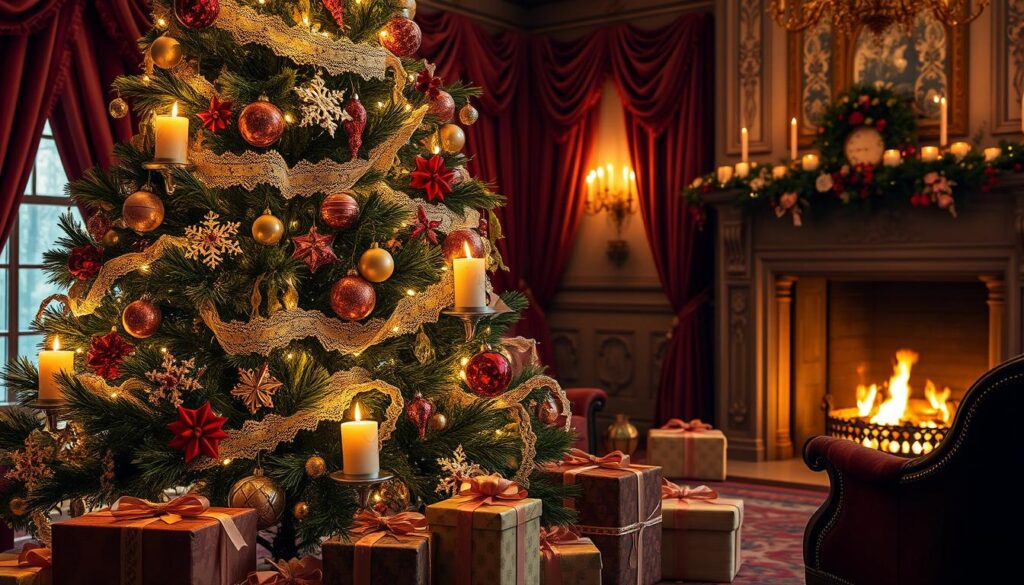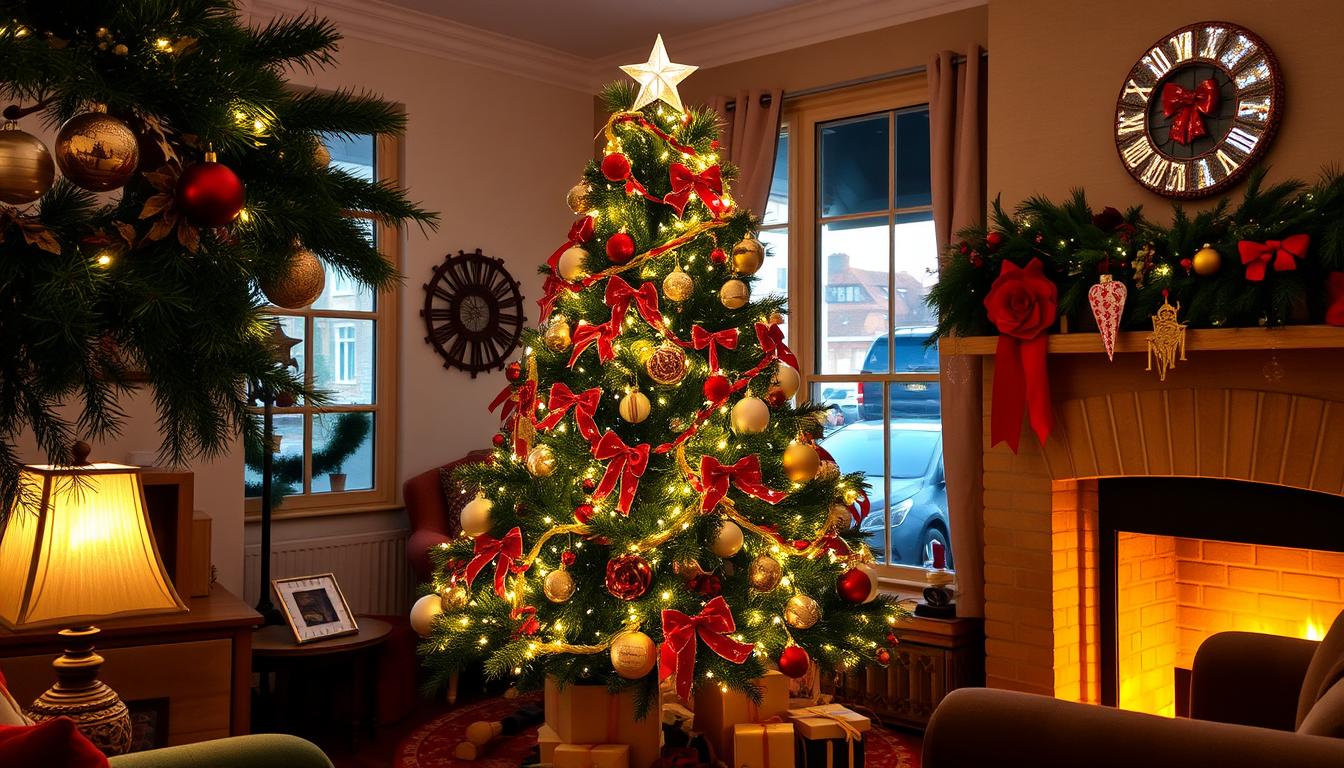The Christmas tree has a long and interesting history. It started with ancient pagan rituals and has become a global holiday tradition. Evergreen plants were seen as special because they stayed green even in winter. They were used to celebrate the winter solstice and other festivals long before Christianity.
In Europe, pagans decorated fir branches, while in Mexico, people used copal tree branches. The evergreen’s symbolism was key in winter festivals around the world.
The Christmas tree we know today started in 16th century Germany. Christians brought decorated evergreen trees into their homes. This tradition quickly spread to Europe. Queen Victoria and Prince Albert made it popular in Britain in the 1840s and 1850s.
Soon, the Christmas tree became a symbol of the holiday season in the United States.
Key Takeaways
- Evergreen plants have been used to celebrate winter festivals for thousands of years, predating the Christian holiday of Christmas.
- The modern Christmas tree tradition originated in 16th century Germany, with the practice of bringing decorated evergreen trees into homes.
- Queen Victoria and Prince Albert played a significant role in popularizing the Christmas tree in Britain, leading to its widespread adoption across Europe and the United States.
- Today, Christmas trees are a beloved tradition embraced by millions of people worldwide, reflecting the rich cultural diversity and history of this enduring holiday symbol.
- The Christmas tree has evolved from its pagan roots to become a cherished symbol of the holiday season, uniting people of different faiths and backgrounds in the spirit of celebration and tradition.
Ancient Origins and Pagan Winter Celebrations
The evergreen tree has always been special in ancient times, especially at the winter solstice. Egyptians started decorating their temples with green palm rushes for Ra, the sun god, around 4500 BC. Celts and Druids also used evergreen boughs, seeing them as symbols of eternal life. The Vikings linked evergreens, like the fir tree, to Balder, their god of light and peace.
The winter solstice, on December 21st or 22nd, was a big deal for ancient cultures. It was the shortest day and longest night. They celebrated it as the sun god’s return, using evergreens to symbolize fertility and new life in winter. These old traditions turned into the modern Christmas tree and other holiday customs.
Evergreen Symbolism in Early Civilizations
Evergreen trees were very important in ancient times. They stood for life winning over death, staying green even in winter. People used them in temples, homes, and ceremonies to connect with nature and celebrate life’s cycle.
Winter Solstice Celebrations
The winter solstice was crucial for ancient cultures. It was the longest night, a time of renewal and the sun’s return. They had big celebrations, using evergreen boughs, candles, and other light symbols.
Religious Significance of Evergreens
Evergreen trees were deeply meaningful in ancient religions. They stood for fertility, renewal, and life’s eternal cycle. Using them in ceremonies helped people connect with nature and celebrate life’s enduring power.
From Roman Saturnalia to Christian Adoption
The Christmas tree’s origins go back to the Roman festival of Saturnalia. This festival was from December 17th to 25th. It was a time of fun, drinking, and decorating homes with evergreen boughs.
As Christianity spread, early Christians set Jesus’ birth on Saturnalia’s last day. This was to attract pagan people to the new religion.
Saint Boniface, an English monk, introduced the fir tree as a Christ symbol in Germany in the 8th century. The fir’s triangular shape was seen as the Holy Trinity.
The Christmas tree’s exact start is unclear, but its roots are in religious influences and cultural significance from Roman Saturnalia and other pagan winter celebrations. Mixing these traditions with Christian symbolism made the holiday we love today.
| Pagan Tradition | Christian Adaptation |
|---|---|
| Decorating homes with evergreen boughs during Saturnalia | Adorning homes with Christmas trees and greenery |
| Celebrating the winter solstice and the return of the sun | Commemorating the birth of Jesus, the “Light of the World” |
| Feasting, drinking, and revelry during Saturnalia | Festive gatherings, feasting, and gift-giving during Christmas |

The mix of pagan traditions and Christian symbolism made the Christmas tree tradition we love today. Its cultural significance is celebrated and passed down, showing the rich religious influences that shaped Christmas.
The History of the Christmas Tree: From Pagan Roots to Modern Tradition
German Christmas Tree Origins
In the 16th century, Germany saw the start of the Christmas tree tradition. Christians decorated evergreen trees with gingerbread, nuts, and apples. These “paradise trees” symbolized life and fertility during the winter solstice.
Martin Luther's Influence
Martin Luther is credited with adding candles to the Christmas tree. He was inspired by starlight through fir trees. This made the tree a symbol of the holiday’s religious meaning.
Paradise Trees and Early Decorations
Early Christmas trees were decorated with gingerbread and gold-covered apples. This reflected the german christmas tree origins and paradise trees from medieval plays. By 1605, Strasburg, Germany, had decorated trees in homes, a tradition that spread.
The martin luther influence and the lasting appeal of paradise trees helped shape the Christmas tree we celebrate today.
Victorian Era and Global Popularization
The Christmas tree tradition changed a lot during the Victorian era. Queen Victoria and Prince Albert were key in making it popular worldwide. An illustration in the Illustrated London News in the 1840s showed the royal family around a tree. This image made the tradition popular in Britain and the United States.
Before then, the Christmas tree was mainly a German custom. But when the royal family adopted it, things changed. German immigrants had brought it to Britain before, but it wasn’t popular until the Victorians took to it. The Victorian era made the Christmas tree a global tradition.
Queen Victoria’s Christmas tree and Victorian Christmas traditions had a big impact. As the British Empire grew, so did the Christmas tree tradition. It spread to colonies and beyond. This period helped make the Christmas tree a key symbol of the holiday season worldwide.

The Victorian era was a big moment for the Christmas tree. It turned from a German custom to a global tradition that’s still celebrated today.
American Christmas Tree Traditions
The Christmas tree tradition in America has grown slowly but interestingly. Early settlers, especially the Puritans, didn’t like it at first. They saw it as a pagan custom. But, German immigrants brought it in the 19th century, and it started to catch on.
Evolution of American Acceptance
Leaders and famous writers helped make the Christmas tree popular. They showed families enjoying gifts under a decorated tree. This made the tree a key part of American holiday celebrations.
White House Christmas Tree Tradition
The White House has been key in making the Christmas tree tradition popular. President Franklin Pierce started the first White House tree in the 1850s. President Calvin Coolidge began the National Christmas Tree Lighting in 1923 on the White House lawn.

Now, American Christmas traditions around the tree keep growing. Families all over decorate their homes with this special symbol. From the White House Christmas Tree to how Americans now accept it, the Christmas tree is a big part of the holiday in the United States.
Christmas Tree Decorations Through the Ages
The history of Christmas tree decorations is as rich as the holiday itself. In the beginning, trees were decorated with simple items like apples and nuts. These humble beginnings show the tradition’s roots.
Later, candles lit up the trees, adding a magical glow. But electric lights changed everything, making decorations safer and more elaborate.
In the 19th century, glass ornaments and tinsel made trees more elegant. By the late 1800s, ornaments were made on a large scale in the U.S. This made decorating trees more common.
In the early 1900s, families went back to making their own ornaments. They used popcorn and berries to create unique decorations.
Now, Christmas trees are a blank slate for creativity. There are countless ornaments and lights to choose from. From simple treats to fancy glass ornaments, the tree’s look has changed a lot. Yet, the spirit of the holiday remains the same.
FAQ
Q: What are the ancient origins of the Christmas tree tradition?
A: Evergreen plants have been a part of winter festivals for thousands of years. Before Christianity, pagans in Europe decorated their homes with fir branches. The ancient Romans also used evergreens to decorate temples during Saturnalia.
Q: How did the modern Christmas tree tradition originate?
A: The modern Christmas tree started in 16th century Germany. Christians brought decorated trees into their homes. Queen Victoria and Prince Albert made it popular in the 1840s, spreading it to England and the United States.
Q: What is the symbolic significance of evergreens in ancient civilizations?
A: Evergreens held deep meaning in ancient times. Egyptians used green palm rushes to honor Ra. Celts and Druids placed evergreen boughs in temples for everlasting life. Vikings linked evergreens to Balder, the god of light and peace.
Q: How did the Christmas tree tradition evolve from pagan winter solstice rituals?
A: The winter solstice marked the return of the sun god’s strength. Evergreens symbolized fertility and new life in the dark winter. This evolved into the Christmas tree tradition we know today.
Q: What is the connection between Saturnalia and the origins of Christmas?
A: Saturnalia was a Roman celebration honoring Saturn. Homes were decorated with evergreen boughs. Early Christians set Jesus’ birth on the last day of Saturnalia to attract pagans. This was a political move to transform Saturnalia into a Christian celebration.
Q: How did the Christmas tree become a symbol of Christianity?
A: Saint Boniface introduced the fir tree as a Christ symbol in Germany in the 8th century. The fir tree’s triangular shape came to represent the Holy Trinity.
Q: What were some of the early decorations used on Christmas trees?
A: Early decorations included gingerbread, nuts, and gold-covered apples. By 1605, people in Strasburg set up decorated fir trees in their homes.
Q: How did the Christmas tree tradition become popularized in the Victorian era?
A: Queen Victoria and Prince Albert made the Christmas tree popular in the 1840s. An 1848 illustration in the Illustrated London News showed the royal family around a tree. This sparked its adoption in Britain and the United States.
Q: How did the Christmas tree tradition evolve in the United States?
A: Early Americans, especially Puritans, saw Christmas trees as pagan. German immigrants brought the tradition, but it gained acceptance in the mid-19th century. Civic leaders and authors promoted it as a family activity to replace old customs.
Q: How have Christmas tree decorations evolved over time?
A: Early decorations included apples, nuts, and gingerbread. Candles lit the tree before electric lights. The 19th century brought glass ornaments and tinsel. By the 1890s, mass-produced ornaments became common in the United States.






